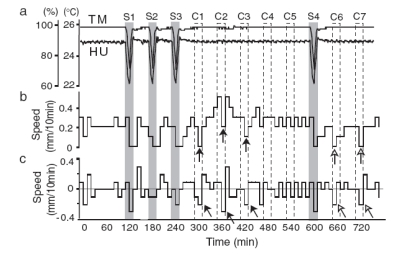
Writing in a recent issue of Physical Review Letters1, researchers in Japan believe they’ve seen behavior complex enough to suggest intelligence in single cell organisms, ie organisms without neurons.
I gave a talk recently in part on the idea that consciousness might arise algorithmically, or from other simple mechanisms. Conventionally, however, we tend to explain intelligence and consciousness as phenomeon rising from aggregations of highly specialized cells, neurons.
The organism is the amoeba Physarum polycephalum, and what you see above is a plot of its speed and acceleration over time. It is confronted with environment changes (cooler, drier air) at points S1, S2, and S3, at which times it slows. Notice, however, that significant periodic velocity changes continue at regular intervals in the absence of further environmental changes, at C1, C2, and C3. Note the periodicity matches the original environmental change timing. These velocity changes then appear to subside, until reinforced by a single change at S4, which reinstates the previous behavior.
The researchers speculate that simple nonlinear dynamics explain the behavior. The journal Nature comments, “Like all living organisms, slime moulds have built-in biochemical oscillators, like the human body clock…The team’s calculations show that such a group of oscillators can pick up and ‘learn’ any imposed rhythmic beat, although the knowledge decays quickly once stimulus ceases.”
The study authors note
It is not common to encounter recurrent environmental changes with periods of 0.51.5 h in nature. Thus, some might consider the capacity to learn a periodicity of this kind to be meaningless. However, the opposite conclusion could also be drawn, namely, that the organism is able to remember periodic changes that it has not experiencedbefore. This indicates that the organism has a generalized capacity for learning, independent of the details of the periodicity.
Discerning a periodicity is not easy, even for humans. According to history textbooks, when the ancient Egyptians recognized the regular periodicity of the flooding of the river Nile and succeeded in anticipating the next flood, this breakthrough triggered the invention of the calendar and was a symbol of the dawn of civilization. It is thus remarkable that a single-celled organism can perform such a function.
Others have tried to explain the seemingly intelligent behavior of single cell organisms in terms of relatively simple chemotaxis, and even via quantum mechanical phenomenon in microtubules. Ironically, much work proceeds in trying to understand the collective intelligence (if you can call it that) of phenomenon like financial markets (and other pyramid building), in terms of nonlinear dynamics.
1. Saigusa, T., Tero, A., Nakagaki, T. Kuramoto, Y. Phys. Rev. Lett. 100, 18101 (2008).
